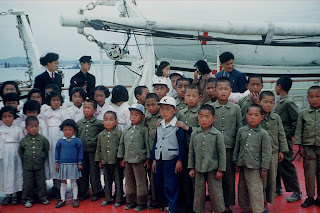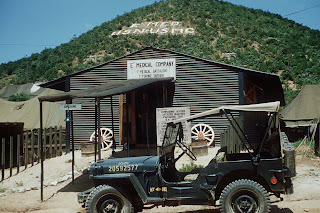 USS Consolation, Inchon Harbor
USS Consolation, Inchon Harbor
Telephone interview with Nancy “Bing” Crosby, Navy nurse aboard USS Haven (AH-12 ) during the Korean War. Conducted by Mr. Jan K. Herman, Historian, Bureau of Medicine and Surgery, 26 December 2001.
Where are you from originally?
Baltimore, MD.
When did you decide you wanted to be a nurse?
When I was a little girl. My mother’s closest friend was a nurse and I guess she influenced me.
Where did you go to nursing school?
Union Memorial Hospital in Baltimore. Then the Navy sent me to the University of Pennsylvania for my baccalaureate, and then to Boston University for my masters. They treated me very well.
When did you join the Navy?
I joined in 1949.
What do you remember about that?
I was a little nervous. My parents never said they were against it at all. We were kind of a Navy family. We grew up with webbed feet. We spent our summers at the Magothy River off of Chesapeake Bay. I was very delighted because both of my brothers were in the Navy. One went to the Naval Academy, and my other brother served in submarines. I was the only one that had to go to war. Would you believe that? Two brothers in the Navy and I was the only one who went to war.
Where was your first assignment?
Bethesda, MD. Then I went to Beaufort, SC, about 2 years later, and then to the Haven.
How did you hear that the war had broken out in Korea?
I don’t remember much about it except that we were at war, Korea was near Japan, and North Korea had invaded South Korea. I heard they needed nurses because they were commissioning a hospital ship and they were looking for volunteers. I was delighted.
So you actually volunteered for service on the Haven?
Oh, yes. All the nurses were volunteers.

USS Consolation and Danish Hospital Ship Jutlandia
Who was your chief nurse?
Nell Harrington. She’s since died. She was a courageous little lady.
What do you remember about reporting to the Haven?
Oh, my, I was impressed. There was a big red cross on the side of it. It had a few rust spots because the men hadn’t finished all the painting. We painted it on the way over to Hawaii and Japan.
Where did you work on the ship?
I worked on the surgical wards because that’s where most of my naval experience had been. I also worked on the A deck for a while with patients with head injuries.
What do you remember about one of your patients, Sergeant Harry Smart?
I don’t remember him specifically because we were so busy then. We were working 18 hours a day. Patients were coming in so fast by helicopter and landing craft.
When did you get to Korea?
We were there in 1952 and ‘53. We went first to Pusan.
Do you remember CAPT Hamblett, the ship’s skipper?
Oh, Balloon Head?
Why do you call him that?
Because he had such a large head. First of all, he got himself a little car that he kept on the deck of the ship so that he would have transportation when he went ashore. He’d go out with the Korean women. He’d want to date us but after we dated him one time, we swore we’d never go again because he was kind of a lecherous fellow. He was bad news.
But he came up with this idea for the two pontoon floats.
Yes, he did.

Hospital Corpsmen carry a critically wounded patient aboard USS Haven
What do you remember about that?
I have pictures I took of those floats. They lashed them to the sides of the ship with great big cables. Then they practiced landing to ensure that the helicopters could land without too much wind influence on the side of the ship. It worked quite well.
Did you see the first flights land?
I don’t remember whether they were the first ones or not but we watched several of them come in. Then they brought the men up on stretchers, lifting them by litter hoist. It was marvelous.
Smaller copters lashed two stretchers, one on each side. Larger copters held several patients.


 Bell HTL-4 aboard one of the Haven's pontoon landing floats, July 1952
Bell HTL-4 aboard one of the Haven's pontoon landing floats, July 1952
And they could land more than one helicopter at a time?
Oh, sure. They could land them on each side of the ship where barges were lashed.
How many on each side?
One at a time on each side.
Were the pontoons decked with wood?
It was wood. They had painted large circles where the copters should land.
How long did you stay on the ship?
I was there pretty close to 20 months.
Were the floats then used while you were in Inchon?
Yes. Later, our helicopter landing pad was built on the afterdeck of the ship and barges were not needed.
I guess that was because you had to stay pretty far offshore because of the tides.
Oh, yes. They were 19- to 21-foot tides; they were impressive. The mud flats used to come out for miles.
You say you took pictures of the floats being used?
Oh, yes. I was impressed by their effectiveness.
How many do you have?
I have about six or eight slides showing the helicopters landing. I also have another one with Nell Harrington climbing into one. I also have slides of critically ill Marines being landed on our helicopter deck on the aft deck of the ship.
How did you get a picture of Ted Williams?
He was a patient on our ship. He was a Marine pilot during the Korean War and was on my ward. When he was getting better I asked him if he would mind if I took a couple of pictures. He was the most gracious fellow.

Marine pilot and Boston Red Sox star, Ted Williams, patient aboard USS Haven, March 1953. Glove courtesy of Haven's Welfare and Recreation Committee.
So he just went up on deck with a baseball glove and posed for you? Where did he get the glove?
Apparently, he kept it with him all the time. He was a neat guy.
 Outside orphanage in South Korea.
Outside orphanage in South Korea.
Did any of the nurses ever get ashore to help Korean refugees?
We didn’t deal with Korean refugees until the battles quieted down. Some of the nurses volunteered to work at the orphanages. I never did that. But we used to get clothes from home for the children and we’d take the children on picnics and distribute the clothes. I have some pictures of that. Between battles we cared for Korean children. They were quickly evacuated when we again became busy. In appreciation, the children were brought to the ship to entertain us with Korean dances.



Do you know any of those nurses who may have worked in the orphanages?
I don’t know whether Pat Leisure did that or not. She worked in the operating room.
Did you treat any Korean patients?
Yes. Frequently, our Korean patients had worms. Because farmers periodically used human excreta for fertilizer, many of our Korean patients had worms. They really caused problems. Patients who had abdominal surgery sometimes needed a Levin tube. These were used to suction stomach contents. Worms frequently clogged the tubes and actually came up around the tube and were pulled from the nose.
 "E" Medical Company, 6 miles from the front
"E" Medical Company, 6 miles from the front

LTJG Crosby aboard USS Haven.
Could you tell me the story of how you and Harry Smart found each other?
It was a delight because he went to a reunion up in North Carolina where he bumped into Frances Omori, the woman who wrote the book about the nurses in the Korean War. She told him that she had interviewed me and that she had my address. So she wrote me and asked if I would mind if she gave him my address. I wrote back to her and said I’d be pleased to talk with him. So he wrote the nicest letter and asked if he could someday come to see me. But we didn’t meet until about 2 years later. Just recently, he drove all the way down to Florida. He lives in Texas, but he was in North Carolina at the time. He drove all the way down just to see me. And we spent 5 hours here talking.
What was that meeting like for you?
Oh, it was very emotional at first. We hugged and cried. It was very warm and touching. I still get emotional when I talk about it. I don’t know where the feelings welled up from but they really were something. I was very, very moved. He made all those years in Korea worthwhile.
He was a Marine patient?
Yes. He says I saved his leg but I don’t remember. But, apparently, I did care for him on the ship. There were so many to care for.
He remembered you because he recalls they called you Bing. And that was your nickname.
Right. Crosby so they called me Bing.
Do you keep in touch?
We write letters and email. He’s a delight. I can’t believe he went to all that trouble to find me.
You were very important to him.
Apparently, I made a difference.
Do you ever think about that time back in Korea?
Yes, particularly when this war’s going on and when they talk about Vietnam. It makes me mad. You always hear about these wars but never hear about the Korean War until recently. And I believe that more of our men were lost in the Korean War than in the Vietnam War.
 Surgery Tent, "E" Medical Company, 1st Medical Battalion, 1st Marine Division, August 1952.
Surgery Tent, "E" Medical Company, 1st Medical Battalion, 1st Marine Division, August 1952.
 Papa-san smokes his pipe. Pusan, April 1952.
Papa-san smokes his pipe. Pusan, April 1952.
 LTJG Virginia Brown, NC, USN, posing beside USS Haven then moored at Pusan, South Korea, March 1953.
LTJG Virginia Brown, NC, USN, posing beside USS Haven then moored at Pusan, South Korea, March 1953.


No comments:
Post a Comment